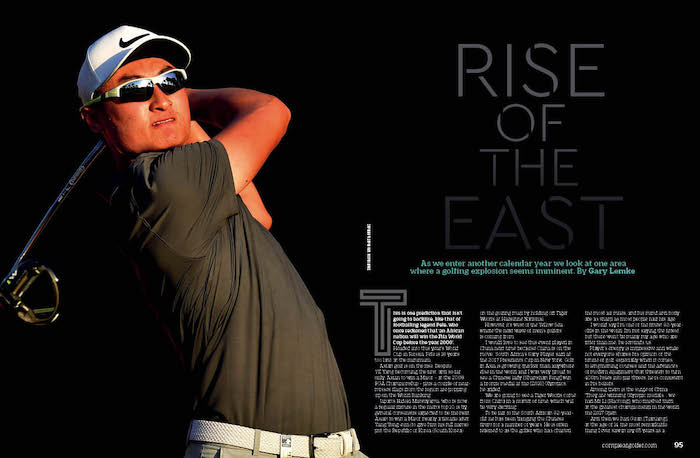As we enter a new calendar year, there is one area where a golfing explosion seems imminent, writes GARY LEMKE in Compleat Golfer.
This is one prediction that isn’t going to backfire, like that of footballing legend Pele, who once reckoned that ‘an African nation will win the Fifa World Cup before the year 2000’. Headed into this year’s World Cup in Russia, Pele is 18 years too late, at the minimum.
Asian golf is on the rise.
Despite YE Yang becoming the first, and so far only, Asian to win a Major – at the 2009 PGA Championship – plus a couple of near-misses, flags from the region are popping up on the World Ranking.
Japan’s Hideki Matsuyama, who is now a regular fixture in the men’s top 10, is by general consensus expected to be the next Asian to win a Major, nearly a decade after Yang Yong-eun (to give him his full name) put the Republic of Korea (South Korea)
on the golfing map by holding off Tiger Woods at Hazeltine National.
However, it’s west of the Yellow Sea
where the next wave of men’s golfers
is coming from.
‘I would love to see this event played in China next time because China is on the move,’ South Africa’s Gary Player said at the 2017 Presidents Cup in New York.
‘Golf in Asia is growing quicker than anywhere else in the world and I was very proud to see a Chinese lady [Shanshan Feng] win a bronze medal at the [2016] Olympics,’ he added.
‘We are going to see a Tiger Woods come from China in a matter of time, which will be very exciting.’
To be fair to the South African 82-year-old, he has been banging the Chinese drum for a number of years. He is often referred to as the golfer who has charted the most air miles, and his mind and body are as sharp as most people half his age.
‘I would say I’m one of the fittest 82-year-olds in the world. I’m not saying the fittest, but there won’t be many my age who are fitter than me,’ he reminds us.
Player’s energy is impressive and while not everyone shares his opinion of the future of golf, especially when it comes to lengthening courses and the advances of modern equipment that threaten to turn 400m holes into par threes, he is consistent in his beliefs.
Among them is the surge of China. ‘They are winning Olympic medals … we had Mr Li [Haotong], who finished third at the greatest championship in the world, the 2017 Open.
‘And then we had Guan [Tianlang], at the age of 14, the most remarkable thing I ever saw in my 65 years as a pro, making the cut at Augusta [in 2013] with a penalty of one stroke [for slow play], and the next week he went to New Orleans on the regular Tour and made the cut again.
‘I have never seen anything that compares to that, so China would be the right spot to go to promote the game.’
Li Haotong is the name that jumps out of the World Ranking, despite the presence of Japan’s Matsuyama.
South Africans got a close-up view of the 22-year-old at the Nedbank Golf Challenge, where he finished fourth behind Branden Grace. Li’s card included six birdies on the back nine, reaching the turn in 30 and another two on the front nine in a bogey-free, week’s-best 64, which left him only four shots behind.
He is making a habit of finishing well. At the 2017 Open Championship at Royal Birkdale, he closed with a round of 63, a day after Grace had set the lowest men’s Major round of 62, and had playing partner Ernie Els purring with admiration.
‘It was a great round,’ Els told the media. ‘Li started off a little bit slow, but I think the birdies on 8 and 9 really freed him up. Then he made an unbelievable save on 10 and 11. He didn’t miss a putt. I don’t know if you saw his birdie on 17 – he came out of a fairway bunker, it was incredible. He did everything he could.
‘It’s not the same number as Gracie yesterday, but it’s just as good a round, given the conditions were much tougher.’
In 2016, Li became the youngest winner of the China Open on the European Tour, aged 20, when an inspired final round of 64 – eight under par – saw him win by three. It remains the only European Tour victory he’s recorded, but shrewd observers reckon it’s only a matter of time before he starts picking up more winner’s cheques.
As a reward for finishing third at The Open, Li booked a place at the 2018 Masters. Fellow Chinese golfers Guan Tianlang and Cheng Jin have already had the chance to play at Augusta, with Guan making the cut in 2013 as a 14-year-old.
Li turned professional in 2011 and it wasn’t long, just two years, before Nike took him under its wing and added him to a stable of stars that then included Tiger Woods and Rory McIlroy.
Tenniel Chu, vice-chairman of Mission Hills Group in southern China, saw Li’s commitment first-hand when he spent his pre-season at the golf resort.
‘The hard work he puts in and the way he dedicates himself to his game makes me believe he can win a Major,’ said Chu.
Li has seen his World Ranking graph head in the right direction. In 2013, he broke into the top 800 and by 2014 he’d gone into the top 200. Towards the end of 2017 he was ranked a career-high 59.
To coincide with his rise, 2017 saw the Chinese player feature in the top 10 five times on the European Tour, while he only missed five cuts, a significant improvement on the 10 in each of 2015 and 2016.
That electric 63 in the final round of The Open saw him finish third and at Sun City a closing 64 pushed him up to fourth. Once you start shooting numbers like that in top company, you are never going to be far away from taking the next step.
And once his name starts appearing on the first page of the leaderboard, the crowds and cameras follow. That isn’t always a good thing, though, as he discovered at last June’s French Open, where he eventually finished in a tie for seventh.
After a poor putting experience on the 11th hole during the first round at Le Golf National, Li hurled his putter into a murky greenside pond. Twenty minutes later, cameras caught an individual rolling up their trousers and wading into the pond, trying to retrieve the putter.
European Tour regulars Tyrrell Hatton, Alex Noren and Thomas Pieters were on the green of the par three and watched the bizarre scene unfold. It was a moment of comedic – or tragic – golf that soon went viral on social media.
The putter was finally retrieved by the determined individual, only for the ‘rescuer’ to discover that Li had indeed snapped the club in half and hurled it into the water in disgust.
It was Li’s mother knee deep in the sludge. ‘Don’t remind me, please,’ Li said later.
There will be plenty of reminders along the way. Asia might be searching for a second Major men’s champion, but the world is waiting for the Chinese men to come through and contest for the top spot on a Major leaderboard.
One thing does seem certain. It won’t take as long as Pele’s pronouncement about an African football nation winning the Fifa World Cup.
THE WOMEN’S GAME
Unlike the men, women’s golf is dominated by Asians where, at the end of November 2017, six of the top 10 in the World Rankings came from that region. And at the very top was the 2016 Olympic bronze medallist, Shanshan Feng, of China (below).
The Asian influence started nearly 20 years ago with the emergence of Se Ri Pak (right). She became the first South Korean to capture a Major, at the 1998 LPGA Championship. Such was her limited grasp of English at the time, Pak didn’t realise it was a Major until after she’d clinched the title.
Pak would go on to win 39 professional tournaments and five Majors. Those who followed in her footsteps were called ‘Pak’s kids’. There have been 11 more Major winners from South Korea since. In 2014, Hyo-Joo Kim carded a round of 61 at the Evian Championship, which is the lowest round by a male or female golfer in a Major.
Life wasn’t always easy for Pak. As a child, her father made her get up at 5:30 every morning and run up and down the 15 flights of stairs in their apartment block to build up her strength. And to overcome her nerves, he made her sleep all night in a cemetery on many occasions. One theory is that the Korean work ethic is ‘stronger’ than most Western counterparts.
– This article first appeared in the January issue of Compleat Golfer







